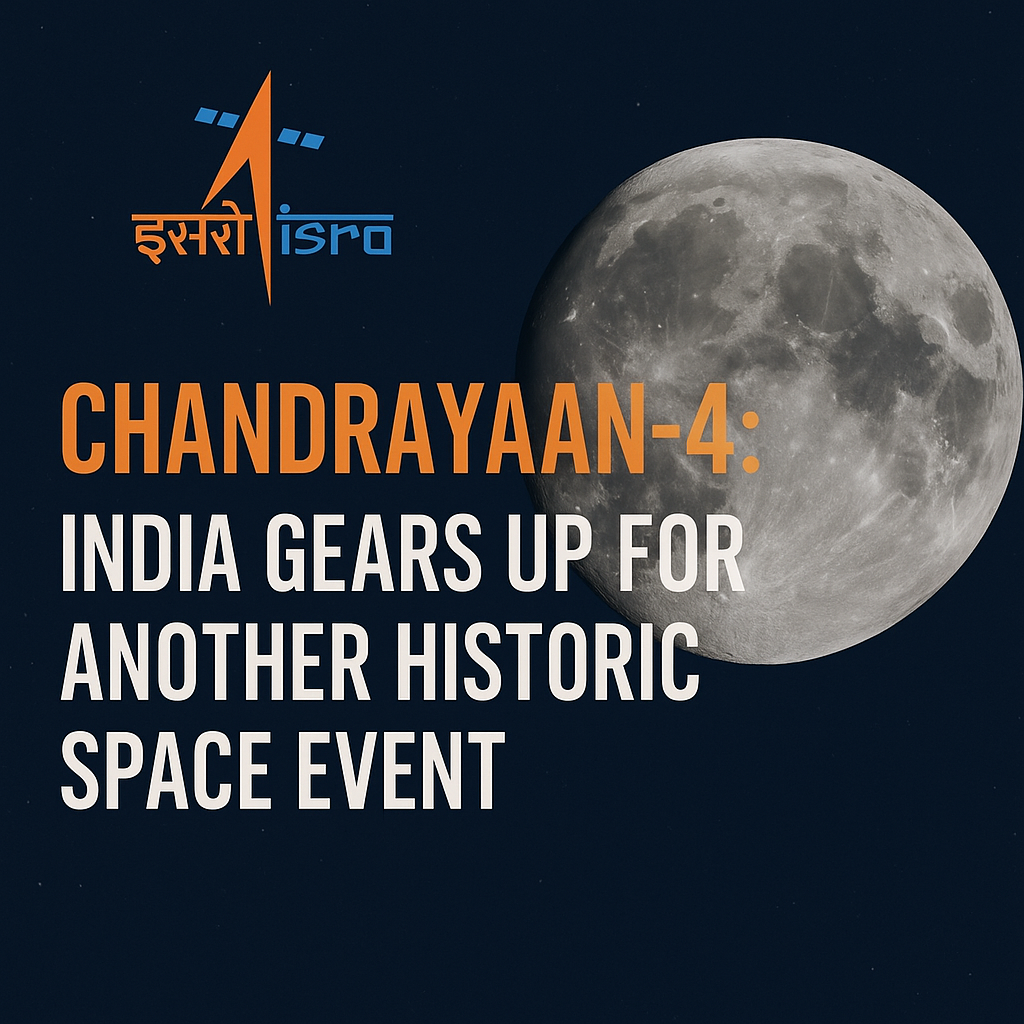India’s space dreams are reaching new heights once again. After the awe-inspiring success of Chandrayaan-3 in 2023, the Indian Space Research Organisation (ISRO) has unveiled plans for an even more ambitious lunar mission—Chandrayaan-4. This proposed mission is not just another milestone but a historic event that has the potential to place India among the few elite nations that have returned samples from the Moon.
This announcement has sparked excitement across scientific communities, the Indian public, and the global space industry. As India prepares for this groundbreaking event, let’s take a deep dive into what it entails, why it matters, and how it could reshape the future of space exploration.
🌕 A Quick Recap: Chandrayaan-3 and its Triumph
Before we delve into Chandrayaan-4, it’s essential to understand the context of ISRO’s recent achievements. On August 23, 2023, Chandrayaan-3 made history by becoming the first mission to successfully land on the Moon’s south pole. This was no small feat. With challenging terrain and extreme temperatures, the Moon’s south pole is one of the most difficult regions to explore.
This successful event not only put India in the global spotlight but also marked it as the fourth country to achieve a soft landing on the Moon after the United States, Russia, and China. It showcased India’s indigenous technological capabilities, careful planning, and dedication to scientific progress.
🛰️ Introducing Chandrayaan-4: The Next Frontier
Now, ISRO is setting its sights higher. The proposed Chandrayaan-4 mission is expected to be India’s first lunar sample-return mission, aiming to bring back soil and rock samples from the Moon. If successful, it will make India only the fourth country in the world to achieve this feat.
While Chandrayaan-3 was about exploration and technology demonstration, Chandrayaan-4 is about science at its core—retrieving material that can unlock secrets about the Moon’s history, structure, and perhaps even the early solar system.
This event will be a multi-module mission involving at least four components:
-
A lander
-
An ascent module
-
An orbiter
-
A return module
Each of these parts must work in flawless coordination to collect samples from the lunar surface, launch them back into orbit, and return them safely to Earth.
🔍 Why This Event Is a Big Deal
This isn’t just another spaceflight—it’s a deeply strategic and scientific event with wide-ranging implications:
1. Scientific Breakthroughs
Lunar samples can answer questions about the Moon’s composition, origin, and potential resources. By analyzing them in Earth-based labs, scientists can investigate:
-
The presence of water ice
-
Volcanic activity in ancient times
-
Solar wind and cosmic radiation impact on the lunar surface
2. Boost to Indigenous Innovation
This mission requires sophisticated mechanisms, including automated sample collection, miniaturized payloads, and high-precision reentry capsules. Successfully executing this mission will boost India’s expertise in interplanetary navigation and autonomous robotic operations.
3. Geopolitical Prestige
Space exploration is often seen as a sign of technological prowess and geopolitical strength. This event will help cement India’s reputation as a serious contender in the global space race.
4. Foundations for Future Missions
This project will serve as a precursor for future human lunar missions and deep space explorations. It lays the groundwork for India’s long-term plan to send astronauts to the Moon and beyond.
🌐 Global Reactions and Collaborations
The announcement of the Chandrayaan-4 mission has garnered attention from the international space community. Agencies like NASA, the European Space Agency (ESA), and JAXA (Japan Aerospace Exploration Agency) have shown interest in collaborating, especially in areas like mission tracking, scientific analysis, and data sharing.
This event is also being closely followed by private space companies, researchers, and academic institutions globally. The data and samples retrieved can offer tremendous value not just to Indian scientists but to humanity’s collective knowledge of the Moon.
📅 Tentative Timeline
While ISRO has not yet confirmed an official launch date, internal sources and reports suggest that the mission is being planned for late 2026 or early 2027. Here’s a likely timeline:
-
2024-2025: Engineering design and development
-
Mid-2025: Integration and system testing
-
Early 2026: Simulation and environmental testing
-
Late 2026/Early 2027: Target launch window
The mission may be launched aboard the GSLV Mk III or an upgraded heavy-lift vehicle, depending on final mass and module configurations.
👩🔬 Technology Behind the Mission
Chandrayaan-4’s complexity makes it one of the most technologically advanced missions ever undertaken by ISRO. The mission will likely use:
-
Autonomous surface sampling systems
-
Reusable orbital modules
-
Advanced heat shields for reentry
-
Precise navigation and docking technology
-
High-resolution imaging and terrain analysis tools
Each module—especially the sample ascent vehicle and Earth-return capsule—must function without human intervention in harsh lunar conditions. This alone makes the mission a highly challenging engineering event.
🗣️ Public Sentiment and Excitement
The public response to Chandrayaan-4 has been overwhelmingly positive. After the emotional moment of Chandrayaan-3’s successful landing, the Indian population—especially students and young scientists—has become more engaged with space science.
This upcoming event is expected to spark widespread enthusiasm once again, with schools, universities, and research centers organizing talks, model-building competitions, and webinars to follow the mission’s progress.
Social media platforms are already buzzing with hashtags like
-
#Chandrayaan4
-
#ISROMission
-
#IndiaOnTheMoonAgain
People across generations are expressing pride, anticipation, and hope for another triumphant mission.
💰 Budget and Resource Allocation
While exact figures haven’t been disclosed, experts estimate that Chandrayaan-4 could cost between ₹1,200 and ₹1,800 crore INR (~$150 to $220 million USD). Given the complexity of a sample-return mission, the higher cost is expected and justified.
The Indian government has signaled strong support for this event by increasing ISRO’s annual budget and encouraging public-private partnerships in space tech. Startups and universities may also play a role in building experimental payloads or communication modules.
🌍 Broader Implications for India and the World
The success of this mission could have a ripple effect beyond just space science. Here are some broader benefits of this monumental event:
-
Educational Impact: Increased interest in STEM education among Indian youth.
-
Economic Growth: Boost to India’s growing private space industry.
-
International Diplomacy: Strengthened ties with space-faring nations and tech partners.
-
Inspiration: Fueling national pride and collective ambition in science and innovation.
📢 Final Thoughts: A Defining Moment in India’s Space Journey
The Chandrayaan-4 mission is not just a mission—it’s a defining event in India’s rise as a space superpower. It exemplifies how perseverance, innovation, and a vision for scientific discovery can lead to world-changing accomplishments.
If successful, this mission will be India’s biggest scientific achievement in space yet, with lasting implications for planetary science and lunar research. More importantly, it will inspire a new generation to dream big—not just to reach for the stars, but to bring a piece of them home.







